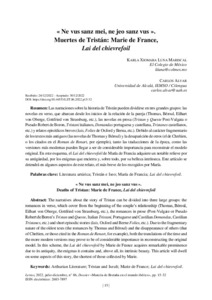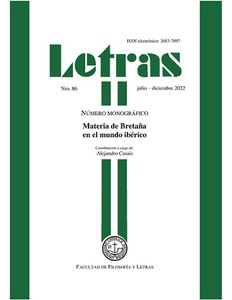Please use this identifier to cite or link to this item:
https://repositorio.uca.edu.ar/handle/123456789/16331| Título: | Ne vus sanz mei, ne jeo sanz vus: Muertes de Tristán : Marie de France, Lai del chievrefoil Ne vus sanz mei, ne jeo sanz vus : Deaths of Tristan: Marie de France, Lai del chievrefoil |
Autor: | Karla Xiomara, Luna Mariscal Alvar, Carlos |
Palabras clave: | LITERATURA ARTURICA; LITERATURA MEDIEVAL; María de Francia; Tristán e Isolda; Lai del chievrefoil | Fecha de publicación: | 2022 | Editorial: | Pontificia Universidad Católica Argentina. Facultad de Filosofía y Letras | Cita: | Karla Xiomara, L. M., Alvar, C. Ne vus sanz mei, ne jeo sanz vus: Muertes de Tristán : Marie de France, Lai del chievrefoil [en línea]. Letras. 2022, (86). doi:10.46553/LET.86.2022.p15-32. Disponible en: https://repositorio.uca.edu.ar/handle/123456789/16331 | Resumen: | Resumen: Las narraciones sobre la historia de Tristán pueden dividirse en tres grandes grupos: las
novelas en verso, que abarcan desde los inicios de la relación de la pareja (Thomas, Béroul, Eilhart
von Oberge, Gottfried von Strassburg, etc.), las novelas en prosa (Tristan y Queste Post-Vulgata o
Pseudo Robert de Boron, Tristani italianos, Demandas portuguesa y castellana, Tristanes castellanos,
etc.) y relatos episódicos breves (lais, Folies de Oxford y Berna, etc.). Debido al carácter fragmentario
de los textos más antiguos (las novelas de Thomas y Béroul) y la desaparición de otros (el de Chrétien,
o los citados en el Roman de Renart, por ejemplo), tanto las traducciones de la época, como las
versiones más modernas pueden llegar a ser de considerable importancia para reconstruir el modelo
original. En este esquema, el Lai del chievrefoil de María de Francia adquiere un notable relieve por
su antigüedad, por los enigmas que encierra y, sobre todo, por su belleza intrínseca. Este artículo se
detendrá en algunos aspectos de este relato, el más breve de los recogidos por María. Abstract: The narratives about the story of Tristan can be divided into three large groups: the romances in verse, which cover from the beginning of the couple’s relationship (Thomas, Béroul, Eilhart von Oberge, Gottfried von Strassburg, etc.), the romances in prose (Post-Vulgate or Pseudo Robert de Boron’s Tristan and Queste, Italian Tristani, Portuguese and Castilian Demandas, Castilian Tristanes, etc.) and short episodic stories (lais, Oxford and Berne Folies, etc.). Due to the fragmentary nature of the oldest texts (the romances by Thomas and Béroul) and the disappearance of others(that of Chrétien, or those cited in the Roman de Renart, for example), both the translations of the time and the more modern versions may prove to be of considerable importance in reconstructing the original model. In this scheme, the Lai del chievrefoil by Marie de France acquires remarkable prominence due to its antiquity, the enigmas it contains and, above all, its intrinsic beauty. This article will dwell on some aspects of this story, the shortest of those collected by Marie. |
URI: | https://repositorio.uca.edu.ar/handle/123456789/16331 | ISSN: | 0326-3363 (impreso) 2683-7897 (online) |
Disciplina: | LITERATURA | DOI: | 10.46553/LET.86.2022.p15-32 | Derechos: | Acceso abierto | Fuente: | Letras No.86, Materia de Bretaña en el mundo ibérico, 2022 |
| Appears in Collections: | LETRAS - 2022 nro. 86 - Materia de Bretaña en el mundo ibérico |
Files in This Item:
| File | Description | Size | Format | |
|---|---|---|---|---|
| ne-vus-sanz-mei.pdf | 267,79 kB | Adobe PDF |  View/Open | |
| cover_issue_471_es_AR.jpg | 39,23 kB | JPEG |  View/Open |
Page view(s)
50
checked on Apr 27, 2024
Download(s)
51
checked on Apr 27, 2024
Google ScholarTM
Check
Altmetric
Altmetric
This item is licensed under a Creative Commons License

